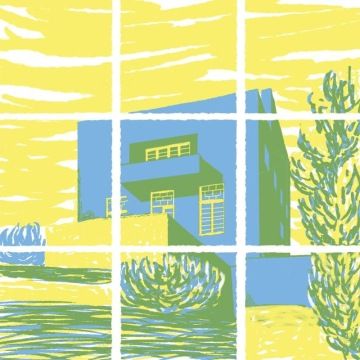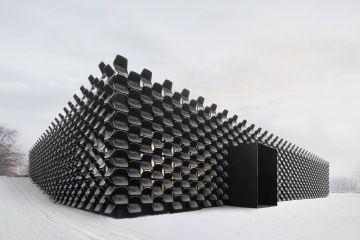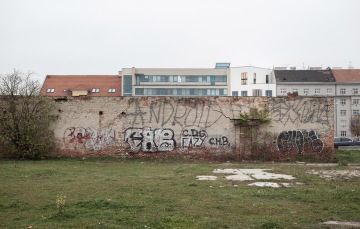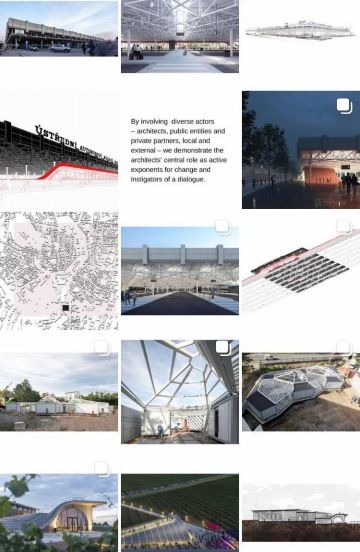THE LIMITS OF ARCHITECTURE – THE INFLUENCE OF SOCIAL NETWORKS ON ARCHITECTURE
Social media has undoubtedly become another reality in which we live our personal and professional lives. Physical and virtual reality are sometimes very difficult to distinguish from each other. Let's think about how much they influence each other. Something as physical as architecture is a good example of this. Moreover, this topic is not new; already Adolf Loos complained that Josef Hoffmann only created two-dimensional buildings that looked good in photographs. What is the influence of Facebook, Instagram, YouTube, etc. on contemporary architectural practice? Does the desire for instagrammable architecture already influence the design process?
Ondřej Chybík and Michaela Trnková accepted the invitation to join the next discussion of the series Borders of Architecture, this time on the topic of the influence of social networks on architecture.
Ondřej Chybík is the co-founder of Chybik + Kristof, a studio based in Prague, Brno and Bratislava / Graduated in architecture and urban planning at the Brno University of Technology, TU Graz in Austria and ETH Zurich in Switzerland / His work has been exhibited at MoMA NYC / He has worked at the Vienna-based studio PPAG / He has been part of international juries of architectural competitions or national architecture prizes in Slovakia and the Czech Republic / He and his studio have won numerous awards, including the AR Design Vanguard 2019
Michaela Trnková is the coordinator of the project focused on media education and media literacy (Un)safely in the network at AMO.
She is currently completing her Master's degree in Cognitive Informatics with a minor in Economic Journalism at the University of Economics in Prague. As part of her studies, she completed two exchange stays at Umeå University in Sweden (2016) and Konkuk University in South Korea (2018). Her work combines her interest in media environment, technology and cognitive science. She has interned at the UN Information Centre, the editorial office of the E15 newspaper and IBM, and is currently working with the technology company Iterait. Her research interests include disinformation, the impact of modern technologies and social networks on society, and media literacy.
Instagram is now considered the most influential network for visually oriented fields such as photography, illustration, design, fashion, architecture, etc. The total number of accounts on Instagram is now over 4 billion and growing. (2020, source statista.com) In such a dynamic and progressive environment, there is competition for likes and attention, which pushes your account closer to the surface and makes it more accessible. Another important area of the network is marketing and paid collaboration, which is mainly used by celebrities with a high number of followers of the account.
A hashtag on Instagram is an informational key to a user's follower area of interest. It defines accessibility and determines the followership of the published post by others. The universal environment of the network gives us the opportunity to choose a local language group in addition to general English and target our presentation locally.

There are over 142 million posts on instagram with the hashtag #architecture.
The Czech version of the hashtag #architektura has just over 1 million posts.
One of the features of social networks is their fluidity. An endless "scroll" through time-layered posts of which only the fresh ones are immediately visible to you. This seemingly chaotic kaleidoscope and impermeable surface is created directly by their users. So is this the most up-to-date happenings in the field of architecture and design?
A comparison of access to relevant information, industry articles and the latest architecture awards leaves us perplexed. Social networks accelerate the flow of information, which is renewed every moment in the viewfinder of our smartphones.
About 30 years ago, architects did not have easy access to professional journals. They didn't have such an overview of what was happening abroad, nor did they have an awareness of what building was being awarded, what was being talked about or what the trends were. What these buildings look like and why they look the way they do. Today, it's just the opposite. Today, Instagram, Facebook and all other networks overwhelm us with a crazy quantum of information.
Certainly this information deluge is having an impact on architecture itself. Probably also by the fact that the architect himself has to make quick decisions under such pressure, choosing only relevant sources or sifting posts through a set filter of individual vision of aesthetics and technology. In a positive sense, selectively, he thus gets a certain picture of what is happening globally.
There are many online platforms, webinars, tutorials and share skills channels to learn how to use social media professionally. How to grow a large community of followers of your business account so that it has a large reach. Likewise, you can pay a coach or PR agency to take your content as far as possible to the benchmark of success beyond thousands of likes per post, where the business is just starting to happen.
Ondřej CHybík personally uses his Instagram purely as a private stream and feed of interesting information. "I pick and choose what I see every day... like architecture schools from around the world like Columbia University in New York or architects that I'm interested in and that's how I actually get to see things I wouldn't otherwise see. That are happening in our industry."
The beauty and degree of aestheticization of this environment is necessary and therefore misleading.
The illusory variables of the social networking environment deny the physical laws we are used to in the physical world. They allow us to resist the shortcomings and obstacles we must otherwise face. Whether it's gravity or social ties in our immediate environment. It's so easy to fall under the spell of this idealism of a better world that we otherwise only dream of.
" ...Actually, it's always been there, because if you've already photographed a model and then wanted to present it, it was about some visual quality anyway. So I don't think there's that much difference today." Chybík thinks in response to the topic of aestheticization of architecture on the social network.
The trendiness and aestheticization here refers mostly to interior architects, who have a high demand for trend and quick realization. Designing already for Instagram, where they want to succeed through the current trend, they deliberately target their realizations to get the "heart" button and this is a bit of a dangerous compromise mentions Ondřej Chybík.
"Self-presentation is a certain condition for success. It doesn't matter what social networks a person uses and whether they are just speaking through social media or being like the medium the network uses. But there are a lot of people who don't use them at all and exist outside their reach."
Among the widely shared presentations of Chybík+Kristof projects circulating on the Internet are two types that Ondřej gives examples of:
We presented a building with chairs on its facade as a short-term installation.
The Gallery of Furniture project was not interesting because of the context in the sense of where the house is located.

The second example from the Chybík+Krištof studio is URBAN INFILL, a seemingly ordinary apartment building and white cube in Brno.
"Like all Brno architects, they build white cubes. We tried to make it a bit different in the sense of some internal organisation. Then, when we were thinking about how to present the finished project, we didn't care anymore that it was a white cube. It was about the context of the place where the house stands, in a neglected part of the city..."
We first invited a photographer to document the house, and he photographed it as a beautiful white cube. He cleaned it up a bit, fixed the fence next door - it wasn't very nice, and the road, the lawn - it wasn't very nice, so he retouched the whole thing.
After the second photographer, we wanted him to take pictures of the house and the mess around it. It was clear to us by then that the strength of the project was going to be in the regeneration of the site and not in the aesthetics of the building. This concept was completely different and our presentations adapted to that. This is not about the unequivocal truth of the picture. It's about what you want to communicate, what topic you want to open up, what you want to talk about and how it has to be understandable to the surroundings.

In retrospect, which was the more successful of the two methods of presentation?
It's not about which was/is more successful. Both presentations were successful because in both cases we communicated what we needed to communicate. In both cases, we showed the whole issue of the project solution in that one photo and gave us the work to realize the core of the problem we want to share and in both cases it worked.
In the second case, of a house in a neglected neighbourhood, it came out clearly and unexpectedly how Brno still looks neglected in some places. Building is hope for such a place, bringing new energy of visible change. By contributing the so-called ugly picture, we raised the eyebrows of our colleagues and opened a debate on the aesthetics of the project's presentation in relation to the surroundings.
Generally relevant and community-recognized reference sources in the field of architecture where we expect quality content are well-known media such as Dezeen, ArchDaily, ...ETC
If we are talking about the level of quality of content shared on networks by anyone without distinction.
It depends if it is so called paid content. It comes to the fore and compromises our ability to distinguish what is and is not quality. This effect spills over into all other areas and affects more than just architecture.
Surprisingly a lot of servers just take over ready-made content to present themselves. We consider older media and magazines - casabella, domus, detail - that have been published for more than 40 years to be of higher quality. The specific curator is the author of the content and the quality is evaluated by consensus in the arch.community, where professional criticism takes place. The published content tries to be publicly criticized, which is part of the architect's profession to withstand this professional criticism.
The key is primary insight and education, what and how to accept, both as an architect and a user must consciously choose what to let in, what to be influenced by, and it certainly shouldn't just be pictures from the internet or a magazine, it's much more intensive work.
"We only get the content on the network that we want to see. We don't see the content we don't like. So we only comment on things we agree with."
Public debates in social networks, not only over the competition projects, provide more space for open dialogue.
The distinction between the real and online space of guided debates is disappearing. We are already living in the interconnection of these worlds, so it is important to engage in critical thinking, considerate behaviour alongside responsibility for published content.
OCH: After the experience of several participatory public projects in Prague, we came to the conclusion that someone has to moderate them. How important it is for people to be given the opportunity to comment on a project that comes to the locality where they live. They have the right to express their opinion and be heard. On the other hand, a lot of individual shouts and differing comments that are usually very specific and not the primary issue of the project,
is necessary to moderate. The moment someone moderates a debate over a project, they are able to work with people and get their input to the core of the issue. That's when the enriching dialogue begins.
Today's person can hardly imagine working offline anymore.
Sharing online the building process, technology and skills is pushing architects professionally on a daily basis. Currently, an architect can reach out directly to colleagues in the industry, potential clients, construction companies, or architecture students and critics. Anyone with an interest in the field can use the instant medium to get to the scene.

On the other hand, building projects are local, whereas a social network environment like IG is global and fundamentally deals with different values and qualities of architecture than public debate in contact with a specific building.
This brings us to the network as a powerful marketing tool, which today is mainly used by developers and real estate agencies more than by the architect and the author of the building itself.
The potential of paid collaboration is thus only used by architects at the level of author's photography of a project, professional criticism or cooperation with an exceptional client.
On social media, we are interested in watching buildings being built. Today, we share online footage of construction so we can get right to the site. We share construction practices, we can look at any time at what was previously hidden from us. We don't even realise that we used to get a complete picture of the project. We are showing a building process that is not actually perfect and that makes it all the more interesting. If we want to reach a new client with our work, they will get the maximum possible information right on Instagram. With the swipe of a finger, he can see all the projects in the moment and we can immediately see if he finds them interesting or not.
The average time spent per user on Instagram is about 150 minutes per day.
MT: The challenge is the level of perfection. We tend to censor our own nature, humanity and imperfections in the artificial environment of networks to improve our own image. The self-presentation of users of some social media accounts leads the entire community to cultivate anxiety over failure, depression and loss of self-esteem. Discipline, education, and a measure of user freedom are important to maintaining mental health.
OCH: There are basically 2 approaches to our social networks. Spontaneous, where Michal or I take pictures on our phone for our instastory, for example how it looks on the construction site. Pretty fun, but you can't just stream. That's why we have a photographer in our office team of 50 who is also responsible for Instagram and another Facebook specialist externally. The two of them fill in strategic templates that they update and complete when a new post needs to be added. It creates a sort of collage of spontaneity and ready-made posts.
"For example, I already know not to post Team-building."
The discussion took place on 11.6.2019 at the Kinolodia in Prague-Holešovice. The series of public discussions and articles The Boundaries of Architecture is supported by a grant from the Czech Architecture Foundation.
Architects without Borders, Karolína Kripnerová, Alžběta Stodolová
Ondřej Chybík, Michaela Trnková
David Přílučík